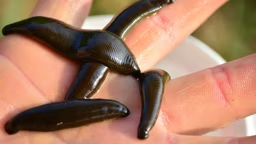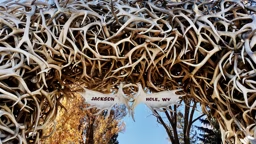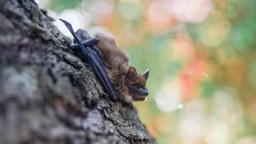Your cabin is supposed to be a haven of peace – a place to get away from the worries of real life. But the peace you seek can get interrupted as raccoons knock over your garbage cans, snakes take up residence near your porch or geese soil your shoreline. If you don’t know how to deal with these nuisances, they can ruin a good vacation. And if you can’t beat them, it may help to know that some pests have clear benefits!
Snakes:
Pest Rating: 8 / Benefit Rating: 8
Most snakes are harmless to humans. Even better: Snakes help control the rodent population. Now there’s a benefit! Still, you don’t want them in your cottage. So, if you discover a snake indoors, calmly guide it out an open door, advises the American Humane Society. If you’re not calm, you may drive it further into hiding. Also, you can try to cover the snake with a container and add a weight on top. Then call an experienced handler to humanely remove the snake. Outdoors, in most circumstances, the snake should be allowed to go its own way.
Venomous snakes, in your cabin or yard, should be removed and relocated by an experienced handler such as your local humane society, animal control agency or professional wildlife control operator. Four kinds of snakes in the United States are dangerous to humans: rattlesnakes, cottonmouths (also called water moccasins) copperheads and coral snakes. To discourage snakes from taking up residence in your yard, remove piles of brush, rocks or wood that may hide snakes and their prey.
Wasps, Yellow Jackets & Hornets:
Pest Rating: 7 / Benefit Rating: 2
Wasps, hornets and yellow jackets pollinate little and can sting a lot. And if anyone in your family has an allergy to the venom, these nasty little pests can be downright dangerous. Benefits? Well, they eat insects like flies and caterpillars that some of us find pesky.
Paper wasps like to build nests in the eaves of your cabin. These guys are no fun, but they’re not incredibly aggressive. You can get rid of them during the day, using a spray you buy at your hardware store. Just don’t stand directly underneath the nest when you spray it – the nest or the wasps can fall right onto you! Remove the nest to deter other critters, such as carpet beetles, from taking up residence.
Yellow jackets, also a kind of wasp, nest in the ground or holes in wood or rock ledges. They can get aggressive and mean. They just love sugary foods and meat – especially at your outdoor meals. If you can find the nest, you can use a spray insecticide late at night, while they are less active. But be careful, as these critters get dangerous when their nest is disturbed. Monitor the nest for several days after you have sprayed to ensure that no yellow jackets have returned. Continue to spray the nest at night if you see more.
Hornets’ nests resemble teardrop-shaped balls and are most typically attached to eaves or tree branches. The University of Kentucky department of entomology warns that since hornets are very dangerous when their nest is disturbed, it is best to call a reliable pest control firm to remove any nests.
Bats:
Pest Rating: 2 / Benefit Rating: 9
There are over 40 species of bats in the U.S. As a primary predator of night-flying insects, bats are highly beneficial – especially for cabin owners in mosquito-prone areas who want to enjoy a summer night out on their decks. In one hour, a lone little brown bat can eat over 1,000 mosquitoes or mosquito-size insects.
Generally, as bats are non-aggressive and only bite in self-defense, you need only leave them alone. But if you find one in your cabin, the Minnesota Department of Natural Resources has some tips. Isolate it in one room by closing the doors to adjoining areas. Open windows or doors that lead to the outside. Turn down lights so the bat doesn’t hide behind curtains or furniture to avoid the light. Remain quiet as you keep track of the bat. Allow it a clear flight path to exit, as it will follow the air currents to the outside.
You can also try to capture it. When the bat lands, place a net or container over it. Slide a piece of stiff cardboard or similar material under the container’s opening. Take the container or net outside and release the bat. When capturing, ALWAYS wear leather gloves for protection.
If you have more than one bat, or they keep entering your cabin, you should try to exclude them. CABIN LIFE’S SEPT/OCT 2007 issue explains how in the “Questions & Answers” column.
Raccoons:
Pest Rating: 6 / Benefit Rating: 4
They look cute in cartoons, but real raccoons spill garbage, dig up gardens and threaten household pets. If your cabin has an uncapped fireplace or open roof soffits leading to an attic in addition to outdoor garbage cans, you may be unwittingly creating an attractive place for raccoons to hang out and create nests.
The best course of action is to make your property as unattractive as possible to the ring-tailed bandits. However, once they have taken up residence, check with your local animal control center to determine if options are available to remove raccoons from your property. The city of Denver offers several recommendations. Screen or cap your chimneys to keep raccoons out. Keep any trees near your cabin pruned back to deny easy access to attic vents. And band the tree trunks with at least 2 feet of sheet metal to keep the raccoons from climbing to reach both attic vents and any bird feeders you have hanging from tree branches. Keep your trash cans in your shed or garage until pickup or drop-off day.
As for benefits, raccoons do eat rodents, although these omnivores eat more invertebrates than vertebrates. Some raccoons also clean up our roads by eating carrion from road-killed animals. And of course, their antics are fun to watch.
Coyotes:
Pest Rating: 6 / Benefit Rating: 4
There are more coyotes living in North America today than ever. Although considered carnivores, they are actually true omnivores. Rural coyotes eat rabbits and rodents along with berries. So rodent control is a big plus. Many of us enjoy coyotes’ nighttime serenades too.
There are some big negatives, but most can be avoided if you make sure coyotes aren’t attracted to your property. Secure your garbage cans’ lids or keep cans in the garage or shed. If you bring your pets to your cabin, be wary. Don’t let any pets run free – they’re too easy for coyotes to catch. Also, don’t leave bowls of pet food or water outside overnight. If possible, feed pets indoors. Put compost in closed containers, not in open areas. Noise and light deterrents may make them stay away too.
Geese:
Pest Rating: 4 / Benefit Rating: 3
Geese are enjoyed by bird-watchers and sport hunters. Plus, geese are good at dispersing seeds and plucking lake weeds.
But geese will stomp a garden flat and eat everything in sight. They can leave droppings all over lawns and shorelines, ruining a walk in bare feet. Their feces also kill grass and spread disease.
Geese can be tough to discourage. It requires educating them to avoid your place. Sonic deterrents like predator noises may scare them away. You can try hanging Mylar balloons, pinwheels or other moving objects near docks or areas that the fowl frequent.
Landscaping tactics may work as well. These include: reducing your lawn area and the amount of young shoots within it; adding native plantings such as long grasses, shrubs or other dense tall plants along your shorelines; and placing boulders of at least 2 feet in diameter between plants. You also can fence areas you don’t want the birds to enter. And don’t forget man’s best friend – a large dog is not a goose’s friend at all.
 Jupiterimages (all photos)
Jupiterimages (all photos) 














